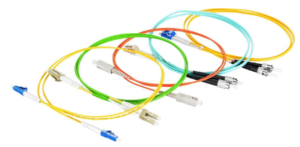
In the world of fiber optics, understanding the differences between Single Mode Fiber (SMF) and Multi Mode Fiber (MMF) is crucial for making the right choice for your network infrastructure. Both types of fiber have their specific uses, advantages, and limitations. This article will explore the key distinctions between SMF and MMF fiber, helping you decide which is best suited for your needs.

What is SMF Fiber?
Single mode fiber (SMF) is designed to carry light signals directly down the fiber with minimal dispersion, making it ideal for long-distance communication. SMF has a smaller core diameter, typically around 8 to 10 micrometers, which allows only one mode or path for the light to travel. This focused pathway reduces the chances of signal loss or degradation over long distances, ensuring that data can be transmitted at high speeds with minimal interference.
Advantages of SMF Fiber
- Long-Distance Transmission: SMF fiber is perfect for long-haul communication, such as in telecommunications or data centers that span large areas. It can carry signals over tens or even hundreds of kilometers without significant loss.
- Higher Bandwidth: Due to its ability to support higher data rates, SMF fiber is suitable for applications requiring large amounts of data to be transmitted quickly, such as in backbone networks.
- Lower Attenuation: SMF experiences less signal loss (attenuation) over long distances, making it efficient for extended connections without the need for repeaters or signal boosters.
Disadvantages of SMF Fiber
- Higher Cost: SMF fiber tends to be more expensive to install and maintain compared to MMF fiber. The precise alignment required for SMF connections also necessitates more expensive transceivers.
- Complex Installation: The small core size of SMF fiber requires more precise splicing and connectorization, which can increase the complexity and cost of installation.
What is MMF Fiber?
Multi Mode Fiber (MMF) is designed to carry multiple light modes or paths simultaneously. It has a larger core diameter, typically around 50 to 62.5 micrometers, allowing it to transmit multiple signals at once. This characteristic makes MMF fiber ideal for shorter-distance applications, such as within a building or a campus.
Advantages of MMF Fiber
- Cost-Effective for Short Distances: MMF fiber is generally less expensive to install and maintain, especially for short-distance applications. The larger core size allows for easier alignment and connection, reducing the cost of transceivers.
- Ease of Installation: The larger core diameter of MMF fiber simplifies splicing and connectorization, making it easier to install and maintain. This can be particularly beneficial in environments where quick setup is required.
- Ideal for High-Speed LANs: MMF fiber is commonly used in local area networks (LANs) and data centers where high-speed data transmission is required over relatively short distances, typically up to 550 meters.

Disadvantages of MMF Fiber
- Limited Distance: MMF fiber is not suitable for long-distance communication. The multiple light paths can cause modal dispersion, where different light modes arrive at different times, leading to signal degradation over longer distances.
- Lower Bandwidth: Compared to SMF, MMF fiber has a lower bandwidth capacity, which limits its use in applications requiring very high data rates over long distances.
Key Differences Between SMF and MMF Fiber
- Core Size: The core size is the most noticeable difference. SMF has a smaller core (8-10 micrometers), allowing only one mode of light to pass through, whereas MMF has a larger core (50-62.5 micrometers) that supports multiple light modes.
- Transmission Distance: SMF is suitable for long-distance transmission, often used in telecommunications and long-haul networks. MMF is better suited for short distances, such as within a building or a data center.
- Bandwidth and Speed: SMF supports higher bandwidth and faster speeds over long distances, making it ideal for backbone networks. MMF, while effective for short distances, has lower bandwidth and speed capabilities compared to SMF.
- Cost: SMF fiber and its associated components (transceivers, installation) tend to be more expensive than MMF fiber. However, the cost difference can be justified by the need for high-speed, long-distance data transmission.
Choosing the Right Fiber for Your Network
When deciding between SMF fiber and MMF fiber, consider the following factors:
- Distance Requirements: If your network requires long-distance data transmission, such as across cities or within large campuses, SMF is the better option. For short-distance communication, such as within a single building or data center, MMF is more cost-effective.
- Bandwidth Needs: For networks that demand high bandwidth and speed, especially over long distances, SMF is the preferred choice. MMF can handle high speeds as well but is limited to shorter distances.
- Budget: Consider your budget for both installation and maintenance. SMF may have higher initial costs, but its long-term performance benefits can outweigh the expense. MMF offers a more budget-friendly solution for shorter distances.
- Future-Proofing: Think about your network’s future needs. If you anticipate the need for higher data rates and longer distances, investing in SMF now might save costs in the long run.
Applications of SMF and MMF Fiber
- SMF Applications: SMF is widely used in telecommunications, long-haul networks, and large data centers. It’s ideal for connecting cities, supporting internet service providers (ISPs), and providing the backbone for global communications.
- MMF Applications: MMF is commonly used in enterprise LANs, data centers, and campus networks. It’s also popular for connecting hardware within buildings, such as between servers and switches.

Conclusion
Understanding the differences between SMF and MMF fiber is essential for choosing the right solution for your network. While SMF offers superior performance for long-distance and high-bandwidth applications, MMF provides a cost-effective and efficient solution for shorter distances. By considering factors like distance, bandwidth, budget, and future needs, you can select the fiber type that best meets your network’s requirements.
Whether you’re setting up a new network or upgrading an existing one, both SMF and MMF have their place in modern communication infrastructure. The key is to match the right fiber type to the specific demands of your network to ensure optimal performance and reliability.







